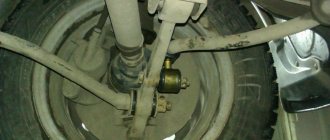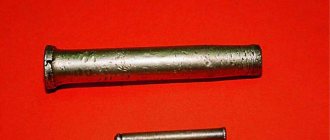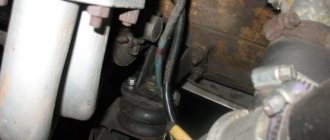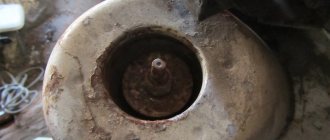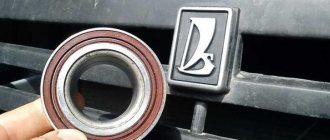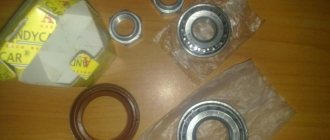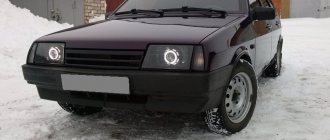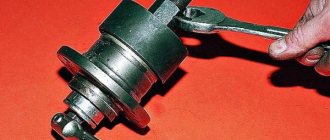Signs of the need to replace stabilizer bushings
The main signs of wear on the stabilizer bushings are knocking and squeaking noises when the car is moving on an uneven road. In this case, it is necessary to immediately replace them with new ones.
To check the condition of the bushings in a garage, you need to strongly shake the stabilizer in the vertical direction. The wear of the bushings will certainly manifest itself as a creaking or knocking sound, and play will be felt in the connection of the stabilizer with the side members and levers. With serviceable bushings, the “stabilizer-spars-levers” combination creates the impression of a single whole.
Replacing stabilizer bushings
There is no need to remove the sway bar to replace the outer bushings. It is enough to remove the mounting brackets. Bracket connections are exposed to water and dirt. Therefore, in addition to a set of keys and a mount, you will need a tool that makes it easier to work with rusted threads. For example, WD-40.
The procedure for replacing the outer bushings is as follows:
- Treat the threads of the studs holding the brackets with an anti-rust agent.
- Unscrew the nuts and remove the brackets, remembering their location.
- Press the stabilizer up, inserting a pry bar between it and the lower arm.
- Remove old bushings.
- Inspect the stabilizer at the bushing attachment points. If significant wear is noticeable, replace it with a new one.
- Put on new bushings.
- Install the brackets and tighten the nuts. It is better to tighten smoothly, in three stages, gradually increasing the force.
To replace the inner bushings, the anti-roll bar must be removed. To do this, you will have to unscrew the brackets at all four mounting points.
Rear anti-roll bar VAZ 2107
In the rear suspension, the role of a stabilizer is performed by the VAZ 2107 transverse link. If you need to further increase the stability of the car, it is necessary to carry out tuning by installing a rear stabilizer bar.
The rear stabilizer of a VAZ 2107 can be made from the front stabilizer of a VAZ 2110. You will also need studs, clamps (or a pipe for their manufacture), one VAZ 2110 torque rod, two VAZ 2110 stabilizer struts and stabilizer rubber bands with fastening clamps.
To work, you need a grinder, a welding machine, a blowtorch, a drill, and a vice.
The procedure for manufacturing and installing the rear stabilizer is as follows:
- Prepare clamps for attaching the rear stabilizer to the bridge by cutting them from a pipe with a diameter of 57 mm.
- Shorten the VAZ 2110 stabilizer by 5-6 cm and bend it 90 degrees, preheating it with a blowtorch. It must be cooled in air; the use of water or oil for cooling is unacceptable.
- Make two stabilizer mounts to the suspension from the VAZ 2110 jet rod, welding them to the stabilizer strut.
- Assemble the structure by installing the bushings.
The steel stabilizer bracket 2107 in the form of a bracket is used to attach the transverse link connecting the lower arms of the front wheels. In classic models of Zhiguli 2101-07 there are 6 such elements. As is the case with other components of these machines, maintenance of the anti-roll bar can be performed by the owner himself, if he so desires. The main thing is to have time and understand what this service involves.
Advantages of installing a rear stabilizer on the seven
To increase stability, a modification of the standard suspension is required, or rather its addition. The main obstacle to improving stability is vehicle roll. The problem with road stability is known not only to owners of sevens, but also to the entire model range starting from the VAZ 2101.
If you install a rear anti-roll bar on a car, the result will be a decrease in lateral grip on one side of the car, as well as an increase in traction on the other. Installing a rear stabilizer on a VAZ 2107 will entail the following advantages:
- Uniform load distribution between suspension elements.
- When cornering, the stabilizer improves handling.
- Aligning the vehicle with respect to the road surface.
If you don’t know whether the part in question is worth installing, then it’s better to ask your friends who drive or have driven a seven. It is definitely worth installing a stabilizer, which not only improves the car’s grip on the road, but also reduces the occurrence of rolls, skids and even rollovers of the car. Stabilizers are not installed on the sevens from the factory, so it will not be necessary to replace the VAZ 2107, but to install a new suspension element.
On the seven you can install two types of stabilizer - double and regular. The difference between them is not only in design, but also in application. The double type of unit is suitable for cases when the car is mostly used on smooth roads, and the single or regular type is suitable for cases when the VAZ 2107 drives on uneven rural off-road conditions. Single devices smooth out the load distribution more smoothly, so in this material we will consider the process of installing a conventional stabilizer on the seven.
Currently, a ready-made version of the stub can be purchased, which is much easier than doing it yourself. Its price starts from 1500 rubles. But next we will consider a more complex option - self-production.
Installation materials and tools
To install the rear anti-roll bar, you need to stock up on the necessary tools and material. First, let's figure out what tools will be needed to install the structure in the suspension of a VAZ 2107 car. Tools needed to modernize the rear suspension:
- Power tools - angle grinder, welding machine, drill.
- Hand tools - wrenches, sockets and ratchet.
- Consumables - abrasive wheel for a grinder, attachment for a drill for grinding.
- Additional tools - sandpaper, solvent, paint.
In addition, you will also need a blowtorch (or gas torch) and a vice to secure the device while processing it. Before you find out how to install a stabilizer on a VAZ 2107 lateral stability, you need to figure out what additional components. materials needed:
- Stabilizer from a VAZ 2110 car.
- Clamps with a diameter of 57 mm.
- There are 2 hairpins, the length of which is 25 cm. The diameter of the hairpins should be 12 mm. Instead of studs, you can use bolts of the appropriate parameters.
- One jet thrust from the “ten” is short.
- Rubber bands for fastening the stub in the amount of 2 pieces.
- Consumables in the form of bolts, nuts, rivets.
- Anti-gravel, which is designed to protect the car body from corrosive effects.
- Stabilizer struts from VAZ-2110.
When all the tools and materials are ready, you can begin to implement the process itself. All other materials and tools are always in the garage of a true driver.
Purpose and design of the unit
VAZ 2101-07 cars use a front stabilizer, whose task is to distribute the load on the chassis when turning, keeping the car in a horizontal position. Without it, under the influence of various forces, the car body will begin to tilt strongly to one side, which, even at average speed, can lead to a coup.
The main part of this unit is a long rod, shaped like the Latin letter U and made of steel with increased elasticity. Car springs are made from the same steel. The ends of the VAZ 2106 stabilizer are attached to the lower arms, and the middle part is attached to the front part of the body. The node consists of the following elements:
Node maintenance
During the operation of classic Zhiguli models, several malfunctions associated with stabilizing traction occur:
- wear of stabilizer bushings on VAZ 2107;
- breakage of the upper or lower pin on which the ends of the rod are screwed to the lever;
- separation of the U-shaped fastening strip welded to the lever at the factory.
Broken studs are quite rare and are the result of metal fatigue. The malfunction is characterized by sharp rolls when turning, accompanied by loud metallic knocks. This unpleasant sound is produced by the released end of the rod clinging to the side of the lower arm. It’s quite easy to fix the damage, even while on the road in the middle of a field: a regular bolt and nut are put in place of the torn stud.
The fastening U-shaped strip of thick metal comes off very rarely. Which entails a labor-intensive process of replacing the lower arm, since welding it to the old one is useless, the part will very quickly break again. If any of these two troubles occur, it is possible to drive a car, but only very slowly, especially on turns.
The VAZ “classic” stabilizer bushings are replaced when they wear out approximately once every 20 thousand km. mileage Wear is clearly visible visually; you just have to look under the front of the car and make sure that the rubber bands are cracked and do not cover the traction properly. In advanced cases, bad bushings make themselves felt while driving, when the car sways and tilts dangerously.
To install new bushings, you will have to completely remove the VAZ stabilizer. It is most convenient to carry out work from the inspection hole, although if necessary, you can do without it. To disassemble and replace, you will need a pry bar, 2 13 mm wrenches and a powerful screwdriver. Replacement is carried out as follows:
- It is easiest to remove the rod when the springs are completely unloaded. Therefore, it is recommended to hang both front wheels of the car.
- Using a 13 mm wrench or socket, unscrew the nuts on all brackets.
- Using a pry bar, remove the brackets from the studs one by one.
- Remove the rod and use a sharp tool to mark the position of the old bushings, as well as the right and left sides.
- Old rubber bands can be cut off with a knife.
When finished, the rod must be thoroughly soaped (do not lubricate it with oil!) and new bushings must be tightened, and then the assembly must be assembled. When assembling, it is undesirable to confuse the right and left ends of the stabilizer, which is why marks were placed on them. In the end, you need to check the car while driving and go to a car service center to correct the wheel alignment of the front wheels.
Stabilizer bracket for VAZ 2101-VAZ 2107
The steel stabilizer bracket 2107 in the form of a bracket is used to attach the transverse link connecting the lower arms of the front wheels. In classic models of Zhiguli 2101-07 there are 6 such elements. As is the case with other components of these machines, maintenance of the anti-roll bar can be performed by the owner himself, if he so desires. The main thing is to have time and understand what this service involves.
Purpose and design of the unit
VAZ 2101-07 cars use a front stabilizer, whose task is to distribute the load on the chassis when turning, keeping the car in a horizontal position. Without it, under the influence of various forces, the car body will begin to tilt strongly to one side, which, even at average speed, can lead to a coup.
The main part of this unit is a long rod, shaped like the Latin letter U and made of steel with increased elasticity. Car springs are made from the same steel. The ends of the VAZ 2106 stabilizer are attached to the lower arms, and the middle part is attached to the front part of the body. The node consists of the following elements:
- barbell;
- mounting bracket - 6 pcs.;
- rubber bushings - 4 pcs.
At the points of attachment, rubber bushings are put on the rod, covered by brackets in the form of brackets, attached to 2 bolts. Although there are only 4 mounting points for the anti-roll bar, there are 6 brackets, since two parts are used in 2 places. These parts have different heights, and in the opening there is a rubber bushing.
When driving in a straight line, the VAZ 2107's lateral stability link is practically inactive. When turning, one lever begins to pull the end of the bar up, the second - down.
Resisting torsion, the rod does not give much movement to the levers in different directions and thereby keeps the car in a horizontal plane.
Node maintenance
During the operation of classic Zhiguli models, several malfunctions associated with stabilizing traction occur:
- wear of stabilizer bushings on VAZ 2107;
- breakage of the upper or lower pin on which the ends of the rod are screwed to the lever;
- separation of the U-shaped fastening strip welded to the lever at the factory.
Broken studs are quite rare and are the result of metal fatigue. The malfunction is characterized by sharp rolls when turning, accompanied by loud metallic knocks. This unpleasant sound is produced by the released end of the rod clinging to the side of the lower arm. It’s quite easy to fix the damage, even while on the road in the middle of a field: a regular bolt and nut are put in place of the torn stud.
The fastening U-shaped strip of thick metal comes off very rarely. Which entails a labor-intensive process of replacing the lower arm, since welding it to the old one is useless, the part will very quickly break again. If any of these two troubles occur, it is possible to drive a car, but only very slowly, especially on turns.
The VAZ “classic” stabilizer bushings are replaced when they wear out approximately once every 20 thousand km. mileage Wear is clearly visible visually; you just have to look under the front of the car and make sure that the rubber bands are cracked and do not cover the traction properly. In advanced cases, bad bushings make themselves felt while driving, when the car sways and tilts dangerously.
To install new bushings, you will have to completely remove the VAZ stabilizer. It is most convenient to carry out work from the inspection hole, although if necessary, you can do without it. To disassemble and replace, you will need a pry bar, 2 13 mm wrenches and a powerful screwdriver. Replacement is carried out as follows:
- It is easiest to remove the rod when the springs are completely unloaded. Therefore, it is recommended to hang both front wheels of the car.
- Using a 13 mm wrench or socket, unscrew the nuts on all brackets.
- Using a pry bar, remove the brackets from the studs one by one.
- Remove the rod and use a sharp tool to mark the position of the old bushings, as well as the right and left sides.
- Old rubber bands can be cut off with a knife.
When finished, the rod must be thoroughly soaped (do not lubricate it with oil!) and new bushings must be tightened, and then the assembly must be assembled. When assembling, it is undesirable to confuse the right and left ends of the stabilizer, which is why marks were placed on them. In the end, you need to check the car while driving and go to a car service center to correct the wheel alignment of the front wheels.
Strengthening stabilizing traction
Some owners of the “classic” VAZ, who love to improve their car in every possible way, have even gotten to the stabilizing unit. There is an opinion that the car behaves better on the road if you install a double stabilizer on the VAZ 2101-07. This modernization improves the car's handling, since rigidity does not allow it to sway and deviate from the trajectory.
To realize the strengthening of the stabilizer, you need to buy the following parts:
- stabilizer rod;
- set of rubber bushings;
- 4 brackets designed for attachment to the lever.
The new rod must be immediately trimmed by 80 mm on each side. Then remove the “original” rod along with the brackets. Further steps - according to the instructions:
- Remove the outer bushings from the “original” rod and clean the ends.
- Place 2 middle bushings on the new rod so that they coincide with the brackets on the old one. Pull the outer rubber bands onto the ends of the rod.
- Pull additional rubber bands on the old stabilizer that match the outer ones on the new one.
- Place the rods together and twist them with brackets placed on additional bushings on both sides.
- Install a reinforced stabilizer on the car.
A similar design can be made by welding from bushings from a Niva and stabilizer struts from a VAZ 2110. This will cost a little more, and the appearance will not be very aesthetically pleasing.
Strengthening stabilizing traction
Some owners of the “classic” VAZ, who love to improve their car in every possible way, have even gotten to the stabilizing unit. There is an opinion that the car behaves better on the road if you install a double stabilizer on the VAZ 2101-07. This modernization improves the car's handling, since rigidity does not allow it to sway and deviate from the trajectory.
To realize the strengthening of the stabilizer, you need to buy the following parts:
- stabilizer rod;
- set of rubber bushings;
- 4 brackets designed for attachment to the lever.
The new rod must be immediately trimmed by 80 mm on each side. Then remove the “original” rod along with the brackets. Further steps - according to the instructions:
- Remove the outer bushings from the “original” rod and clean the ends.
- Place 2 middle bushings on the new rod so that they coincide with the brackets on the old one. Pull the outer rubber bands onto the ends of the rod.
- Pull additional rubber bands on the old stabilizer that match the outer ones on the new one.
- Place the rods together and twist them with brackets placed on additional bushings on both sides.
- Install a reinforced stabilizer on the car.
Double stabilizer for classic VAZ
How to make a double front stabilizer for a classic VAZ (2106, 2107, 2101) with your own hands.
Detailed instructions for the manufacture and installation of a double vase stabilizer - several options. The front double (reinforced) stabilizer increases the vehicle's stability in corners (due to its rigidity) and improves handling. Such tuning of vases will not take much time and will not require much effort, and the effect will be noticeable immediately.
To make it, you will need the following spare parts (you can buy it in a store or at a car market).
— Front stabilizer VAZ 2101 or VAZ 2106 VAZ catalog number — 2101-2906010
— Stabilizer strut 2110 – 4 pieces. VAZ catalog number - 2110-2906050
— Stabilizer bar cushion 2121 V — 2 pieces. VAZ catalog number - 2121-2906040
— Anticorrosive (anti-gravel) and fairy for washing dishes. First you need to prepare the extreme mounts for the second stabilizer to the first.
What is a rear stabilizer
The rear stabilizer for the VAZ 2107 is a curved C-shaped rod installed next to the rear axle of the “seven”. The stabilizer is attached at four points. Two of them are located on the rear suspension arms, two more on the rear side members of the “seven”. These fasteners are ordinary eyes with dense rubber bushings inside (these bushings are the weak point of the entire structure).
Today you can purchase a rear stabilizer and fasteners for it at any spare parts store. Some drivers prefer to make this device themselves, but this is a very labor-intensive process that requires certain skills that a novice car enthusiast simply does not have. That is why the replacement of bushings on a finished stabilizer will be discussed below.
Purpose of the rear stabilizer
The anti-roll bar on the “seven” performs two important functions at once:
- this device gives the driver the opportunity to control the tilt of the car’s chassis, while the force acting on the camber of the rear wheels practically does not increase;
- After installing the stabilizer, the tilt of the suspension between the axles of the car changes significantly. As a result, the driver is able to better control the car;
- The improvement in car control is especially noticeable on sharp turns. After installing the stabilizer, not only does the lateral roll of the car during such turns decrease, but you can also take them at a higher speed.
About the disadvantages of the rear stabilizer
Speaking about the advantages that the stabilizer provides, one cannot fail to mention the disadvantages that also exist. In general, the installation of a stabilizer still remains the subject of fierce debate among car enthusiasts. Opponents of installing stabilizers usually justify their position with the following points:
- Yes, after installing the rear stabilizer, lateral stability increases significantly. But this is a double-edged sword, since it is the high lateral stability that makes it much easier for the car to skid. This circumstance is good for those who engage in so-called drifting, but for an ordinary driver who finds himself on a slippery road, this is completely useless;
- If a car enthusiast decides to install a rear stabilizer on his “seven”, then he is strongly recommended to install a front one, and not a regular one, but a double one. This measure will help prevent excessive loosening of the car body;
- The cross-country ability of a car with stabilizers is reduced. On sharp turns, such a car often begins to cling to the soil or snow with its stabilizers.
Thus, a driver who is thinking about installing stabilizers should weigh all the pros and cons as carefully as possible, and only after that make a final decision.
Rear suspension - description
The rear suspension of the VAZ 2107 is practically no different from the mechanism of other classic Zhiguli cars. The dependent design is simple, but has some features. Its main structural elements are:
- springs;
- telescopic shock absorbers;
- rods;
- beam.
Design of the rear suspension of the VAZ 2107: 1. Lower longitudinal rod; 2. Lower insulating gasket of the suspension spring; 3. Lower support cup of the suspension spring; 4. Compression stroke buffer; 5. Bolt for fastening the upper longitudinal rod; 6. Bracket for fastening the upper longitudinal rod; 7. Suspension spring; 8. Compression stroke buffer support; 9. Upper spring gasket ring; 10. Upper spring insulating gasket; 11. Upper support cup of the suspension spring; 12. Pressure regulator drive lever support; 13. Rubber bushing for the pressure regulator drive lever; 14. Shock absorber mounting stud washer; 15. Rubber bushings for shock absorber eye; 16. Rear shock absorber mounting bracket; 17. Additional compression progress buffer; 18. Spacer washer; 19. Spacer sleeve of the lower longitudinal rod; 20. Rubber bushing of the lower longitudinal rod; 21. Bracket for fastening the lower longitudinal rod; 22. Bracket for fastening the upper longitudinal rod to the bridge beam; 23. Spacer sleeve for transverse and longitudinal rods; 24. Rubber bushing for the upper longitudinal and transverse rods; 25. Rear shock absorber; 26. Bracket for attaching the transverse rod to the body; 27. Brake pressure regulator; 28. Protective cover for pressure regulator; 29. Pressure regulator drive lever axis; 30. Pressure regulator mounting bolts; 31. Pressure regulator drive lever; 32. Clip of the lever support sleeve; 33. Support sleeve; 34. Cross rod; 35. Cross bar mounting bracket support plate
Rear beam
The main structural element of the rear suspension is a beam (stocking) or rear axle, through which the rear wheels are connected to each other. With the help of this unit, not only the suspension elements are fixed, but also the rear axle structure - the gearbox and axle shafts - is assembled together.
The main element of the rear suspension is the stocking
Shock absorbers
The main function performed by suspension shock absorbers is vibration damping, i.e., preventing the car from rocking when driving over uneven surfaces. The presence of such an element and its proper operation directly affects the predictability of the car’s behavior, as well as the comfort of movement and extending the service life of other suspension elements. The upper part of the shock absorber is attached to the power element of the body, and the lower part is attached to the rear axle beam through a bracket and rubber bushings.
Shock absorbers act as elements that dampen vibrations
Springs
Another integral element of both rear and front suspension is the spring. In addition to shock absorbers, it also provides a comfortable ride. In addition, the element prevents the vehicle from tipping over when making sharp turns. By design, the spring is made of a steel rod twisted into a spiral.
The spring, in addition to shock absorbers, is responsible for comfortable movement in the car.
Jet thrusts
The rear axle stocking is fixed to the body of the “seven” using reaction rods. The latter are present in the amount of five pieces - four longitudinal and one transverse (Panhard rod). Longitudinal rods prevent and prevent the bridge from moving back and forth, and transverse rods prevent movement when lateral loads appear. The rods are connected to the rear axle beam through rubber bushings.
Reaction rods of the rear axle keep it from longitudinal and lateral displacements
Bumpers
The rear suspension compression buffers are made of rubber, are inserted into the body holes provided for them and are located inside the springs. An additional bumper is installed above the rear beam and secured to the bottom of the car. The purpose of the buffers is to prevent hard impacts when driving on bad roads when the suspension is fully compressed.
Rear suspension bumpers prevent breakdown during heavy sagging
Bumpers
Signs of a broken rear stabilizer
It’s not difficult to guess that something is wrong with the rear stabilizer of the VAZ 2107. Here's what's observed:
- a characteristic grinding or creaking noise, which is especially clearly heard when entering a sharp turn at high speed;
- a significant increase in vehicle roll when cornering and a decrease in controllability when cornering;
- the appearance of play on the stabilizer. Play can be easily detected by placing the car in an inspection hole and simply shaking the stabilizer bar up and down;
- destruction of bushings. The play mentioned above is almost always accompanied by the destruction of rubber bushings. They are squeezed out of their eyes, crack and completely cease to perform their functions.
All of the above things indicate only one thing: it’s time to repair the stabilizer. In the vast majority of cases, repairing the rear stabilizer comes down to replacing damaged bushings, since the fasteners and rod rarely need repairs. Such a need may arise only in the event of serious mechanical damage, when the driver caught a large stone or curb with the stabilizer, for example.
How should the stabilizer be positioned?
A properly installed stabilizer should be able to twist under the influence of forces on the wheels, and it should do this even when the forces applied to the right and left wheels are directed at completely different angles.
Replacing bushings for the rear stabilizer of a VAZ 2107
Worn rear stabilizer bushings cannot be repaired. They are made of special wear-resistant rubber. It is not possible to restore the surface of this rubber in a garage: the average car enthusiast has neither the appropriate skills nor the appropriate equipment for this. Therefore, there is only one way to solve the problem of worn bushings: replace them. Here are the tools and consumables you will need for this job:
- a set of new bushings for the rear stabilizer;
- set of open-end wrenches;
- flat screwdriver and hammer;
- composition WD40;
- mounting blade.
Sequence of operations
It should be said right away that it is most convenient to carry out all work in an inspection hole (as an option, you can park the car on an overpass).
- After installation on the pit, the stabilizer fasteners are carefully inspected. As a rule, all the bolts on it are covered with a layer of dirt and rust. Therefore, it makes sense to treat all these compounds with WD40 and wait 15 minutes. This time will be enough to dissolve dirt and rust.
- The mounting bolts on the stabilizer clamps are unscrewed with a 17mm open-end wrench.
Replacing the front springs of a VAZ 2107
- set of wrenches;
- jack (screw or hydraulic);
- wheel wrench;
- metal brush;
- hammer;
- mounting blade;
- insulating tape;
- wire hook.
- jack up the car and remove the wheels;
- remove the shock absorber;
- loosen the front arm nuts;
- put the car on a block and jack up the lower arm to make it easier to remove the stabilizer;
- unscrew the stabilizer cushion mounting bracket and remove it;
- remove the jack from under the lower arm;
- loosen the nut from the lower ball joint pin without unscrewing it completely;
- carefully knock out the support pin from the steering knuckle;
- support the lower arm with a jack without loading it;
- unscrew the nut from the lower ball joint pin and lower the lower arm;
- secure the upper arm with a wire hook;
- pry the spring with a mounting blade at the bottom and remove it;
- remove the spring gasket;
- check the condition of the gasket, replace if necessary;
- attach the gasket to the new spring using electrical tape;
- insert the spring into place using a mounting spatula;
- smoothly lift the lower arm with a jack, controlling the position of the spring and inserting the lower ball pin into the steering knuckle;
- Assemble the suspension parts in the reverse order of disassembly and install the wheel.
